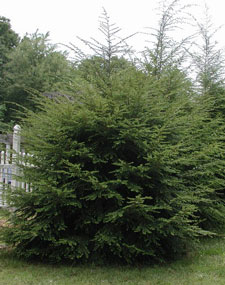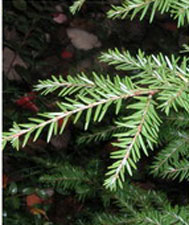Resource Library
Plant of the Week: Hemlock, Canadian
The University of Arkansas System Division of Agriculture does not promote, support or recommend plants featured in "Plant of the Week." Please consult your local Extension office for plants suitable for your region.
Plant of the Week
Canadian Hemlock
Latin: Tsuga Canadensis

In the winter, we appreciate evergreen trees because they stand like sentinels in the winter landscape. One evergreen tree, the Canadian hemlock, breaks the mold of most evergreens by having a graceful, almost delicate form.
Nine species of hemlock are described with five from Asia, two from western North America and two from the eastern forests. Canadian hemlock (Tsuga canadensis) has the widest range of these, extending from southern Canada to northern Alabama along the Appalachian Mountains. Though forest giants more than 150 feet tall were known before European settlement, today it’s seldom seen growing taller than 60 feet with a 20- to 25-foot spread. It has a pyramidal form with shingled branches that aid it in withstanding wintertime snows.
Canadian hemlock needles are flat, dark green above and whitened below and about ½-inch long and a tenth of an inch wide. They are arranged along the young branches in a two-ranked fashion. The cones are brown and about the size and shape of a small pecan.
Canadian hemlocks are climax species in the forest, being one of the few tree species with seedlings that will grow in dense shade. While its growth is slow under heavy shade, it’s relentless, and eventually trees overshadow other species in the stand.
In the days before the great eastern forests were cut, especially along our current border with Canada from Michigan to New York, it used to form dark, gloomy forests where little light penetrated to the ground. But it is particular about its growing conditions, preferring cool, uniformly moist, but always well drained sites, where it’s protected from hot, drying winds.
Noted horticulturist U. P. Hedrick, in his autobiography The Land of the Crooked Tree (Oxford University Press, 1948)¸ tells of the cutting the giant hemlock forest on his father’s farm in the upper peninsula of Michigan during the summers in the 1880s. He describes the trees as having trunks 2 feet to 4 feet across with boles limbless up to 50 feet.

The trees were felled by ax; the thick bark peeled off and then stacked in cords 4 x 4 x 8 feet. A single tree could produce two cords that sold for $3 to $5 each. The bark - called tanbark - was sold to tanneries that used its naturally high tannin content in the tanning process. As recently as 30 years ago, tanbark mulch, a byproduct of the tanning industry, was still being sold as a landscape mulch. Today, little leather tanning goes on in the United States. The giant trunks left over after being skinned were skidded into piles using oxen and burned or left to rot away in place.
Canadian hemlocks are useful in landscape sites where an evergreen screen is needed in a shaded location. They also make good specimen plants. In the northeastern states, they have been used as a landscape plant, but in such situations they quickly outgrow most locations. An effective screen planting can be had in five years time by planting trees 6 feet apart in a row. These trees tolerate shearing, so if the height of the screen planting needs to be controlled, it can be easily accomplished by pruning back in the spring before new growth resumes.
Canadian hemlocks are hardy from zones 3 to 8, but in the southern end of their range they should only be used in shaded or north-facing sites. They’re best planted in an organic, acidic soil. They’re intolerant of drought or hot, dry winds.
Of late, an insect pest, the hemlock wooly adelgid, an introduced pest from Asia that has been in the United States since 1924, has become a significant threat to native hemlock stands. It has spread along the eastern seaboard from New Hampshire to northern Georgia and currently occupies about half of the native range of the species. Biological controls are being introduced to combat this pest, and hopefully will prevent the further spread of the insect.
By: Gerald Klingaman, retired
Extension Horticulturist - Ornamentals
Extension News - January 18, 2008
The University of Arkansas System Division of Agriculture does not maintain lists of retail outlets where these plants can be purchased. Please check your local nursery or other retail outlets to ask about the availability of these plants for your growing area.